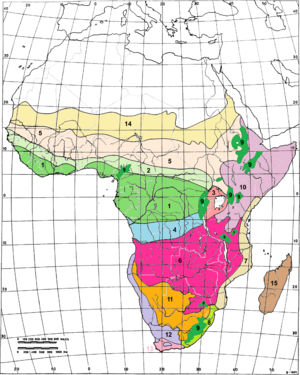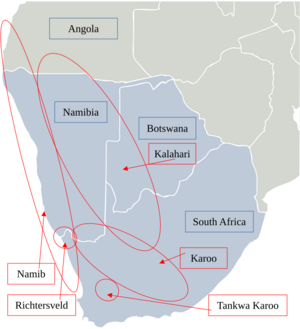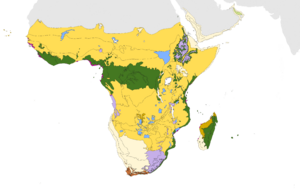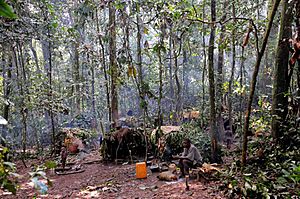Afrotropical realm facts for kids
The Afrotropical realm is one of Earth's eight big nature regions. It includes Africa south of the Sahara Desert, the southern Arabian Peninsula, the island of Madagascar, and the islands in the western Indian Ocean. It used to be called the Ethiopian Zone or Ethiopian Region.
Contents
Amazing Nature Regions

Most of the Afrotropical realm has a tropical climate. This means it's usually warm all year. Huge deserts like the Sahara in northern Africa separate this realm from the Palearctic realm to the north.
Sahel and Sudan Grasslands
South of the Sahara Desert, you'll find two long belts of tropical grasslands and savannas. These stretch from the Atlantic Ocean to the Ethiopian Highlands.
- The Sahel is a dry area with short grass and acacia trees. It's a transition zone right next to the Sahara.
- Further south is the Sudanian Savanna, also called the Sudan. Here, the grass is taller. This area has two huge wetlands: the Sudd in South Sudan and the Niger Inland Delta in Mali.
- Between the grasslands and the thick forests is a mix of forest and savanna.
Southern Arabian Woodlands
The southern part of Arabia, including Yemen and parts of Oman and Saudi Arabia, has very few permanent forests. Some small woodlands exist, mostly with Juniperus or Vachellia trees.
Tropical Forest Zone
A large belt of tropical moist broadleaf forests runs across the middle of Africa.
- The Upper Guinean forests are in West Africa, from Guinea to Togo.
- The Dahomey Gap is a break in the forest, where savanna reaches the coast.
- The Lower Guinean forests are from Benin through Cameroon and Gabon to the western Democratic Republic of the Congo.
- The biggest tropical forest in Africa is the Congolian forests in the Congo Basin.
- There are also tropical forests along the Indian Ocean coast, from southern Somalia to South Africa.
Somali–Masai Drylands
In northeastern Africa, you'll find dry woodlands, savannas, and bushlands. This area is called the Somali-Masai region. It stretches from central Tanzania north through the Horn of Africa. It has thorny trees like Acacia and Commiphora. The Serengeti ecosystem, famous for its wildlife, is in this region.
Eastern Africa's Highlands
The Afromontane region includes high mountains from the Ethiopian Highlands to the Drakensberg Mountains in South Africa. These mountains have special plants like Podocarpus and giant Lobelias.
- Ethiopian Highlands
- Albertine rift montane forests
- East African montane forests
Zambezian Region
The Zambezian region has woodlands, savannas, and grasslands. It includes areas like Miombo woodlands and drier mopane woodlands. This region stretches across Africa, south of the rainforests and north of the southern deserts. Countries here include Malawi, Angola, Botswana, Mozambique, Zambia, and Zimbabwe.
Southern African Deserts
Southern Africa has several deserts.
- The Namib Desert is one of the oldest deserts in the world. It runs for over 2,000 kilometers along the Atlantic coasts of Angola, Namibia, and South Africa. It has huge sand dunes and unique animals.
- The Kalahari Desert is a semi-dry savanna in Botswana, Namibia, and South Africa. It's known for its diamonds and various plants.
- The Karoo is a semi-desert region in South Africa. It has wide-open spaces and special plants like certain Asteraceae flowers.
- The Richtersveld is a mountainous desert in South Africa. It's a World Heritage Site because of its unique nature and importance to the local Nama people.
Cape Floristic Region
The Cape floristic region is at the very southern tip of Africa. It has a Mediterranean climate and many plants found nowhere else. It's famous for plants like the proteas.
Madagascar and Indian Ocean Islands
Madagascar and nearby islands are very special. They have many unique animals, like lemurs, that live only there. Madagascar and the Granitic Seychelles are ancient land pieces that broke away from Africa millions of years ago. Other islands, like the Comoros and Mascarene Islands, are younger volcanic islands. Madagascar has many different habitats, from rainforests to deserts, and a huge variety of life.
Special Plants and Animals
Plants
The Afrotropical realm has many plant families found only there.
- Madagascar and the Indian Ocean Islands have ten plant families found nowhere else.
- South Africa has twelve plant families that are almost entirely unique to the area.
- Other unique plant families in the Afrotropic include Barbeyaceae and Montiniaceae.
Animals
This realm is home to many amazing animals.
- The Great Lakes of East Africa (Victoria, Malawi, and Tanganyika) are home to many freshwater fish, especially cichlids. They have more than two-thirds of the world's cichlid species!
- The Afrotropic has unique bird families like ostriches, sunbirds, secretary birds, guineafowl, and mousebirds.
- Africa has three unique groups of mammals: aardvarks, tenrecs and golden moles, and elephant shrews.
- The East African plains are famous for their many large mammals, like zebras, giraffes, and lions.
- Four types of great apes (Hominidae) live only in Central Africa: both kinds of gorilla and both kinds of chimpanzee. Scientists believe that Humans and their early ancestors first appeared in Africa.
Afrotropical Nature Regions
The Afrotropical realm has many different types of nature areas, called ecoregions. These include:
- Tropical and subtropical moist broadleaf forests (thick, wet forests)
- Tropical and subtropical dry broadleaf forests (forests that lose leaves in dry season)
- Tropical and subtropical grasslands, savannas, and shrublands (grassy areas with scattered trees)
- Temperate grasslands, savannas, and shrublands (cooler grassy areas)
- Flooded grasslands and savannas (wetlands)
- Montane grasslands and shrublands (mountain grasslands)
- Mediterranean forests, woodlands, and scrub (areas with dry summers and wet winters)
- Deserts and xeric shrublands (very dry areas)
- Mangroves (coastal forests that grow in salty water)
Forest Habitats
Tropical African forests are very rich in different kinds of plants and animals. They cover a huge area, especially in Central and West Africa.
These rainforests are some of the oldest and most complex natural systems on Earth. They are super important for the planet's climate and for storing carbon. However, many of these forests are shrinking.
There are two main types of rainforests in West Africa:
- Semi-deciduous rainforests: These trees lose their leaves during the dry season. They are found in areas with a dry period of about three months.
- Evergreen or semi-evergreen rainforests: These trees stay green all year. They are in wetter areas where the dry period is shorter. These forests are usually richer in different plant species.
Compared to rainforests on other continents, most African rainforests are a bit drier. They get between 1600 and 2000 mm of rain each year. The variety of plants in African rainforests is also a bit less than in other rainforests around the world.
Forest Animals
African rainforests are home to many animals, especially smaller mammals. New species are still being found! Sadly, many species have also disappeared. Forests that are not disturbed are the best homes for many animals. But today, truly undisturbed rainforests are rare. When trees are cut down for timber, it changes the forest and harms the animals that live there.
Animals like the pygmy hippopotamus, giant forest hog, water chevrotain, and many types of monkeys live in these forests. The top parts of the trees are home to monkeys like the red colobus and Black-and-white Colobus. Many of these unique animals are now endangered and need protection from poachers and habitat loss.
Forest Plants
In Tropical Africa, about 8,500 plant species have been found, including 403 types of orchids.
If forests continue to be cut down for timber or farming, many plant and animal species might not survive. Rainforests are home to almost half of the world's animals and plants. They also offer important resources for people in developing countries. Experts worry that West Africa's rainforests could disappear by the year 2020 if deforestation continues at the current rate.
Africa's rainforests are also very important to the indigenous peoples of Africa who have lived in them for thousands of years.
Protecting the Region
Many African countries are going through big changes, and sometimes conflicts make it hard to manage forests well. Laws are being made to help use forests and wildlife in a balanced way. This helps the country's economy, society, and science.
Deforestation
Deforestation means clearing forest land completely for things like farming, plantations, or cattle ranching. Other changes include breaking up forests into smaller blocks and cutting down specific trees for money.
- Countries with faster population growth often have more rainforest loss.
- One big reason for forest loss is growing "cash crops" like gum, rubber, and palm oil. These products are important for countries' income.
- Another cause is cutting down trees for timber. Richer countries use a lot of wood, and after World War II, there was a big demand for tropical wood from West Africa.
- People also cut down trees for firewood, which is a main source of energy in many parts of Africa.
The rainforests that are left in West Africa are very different from how they were 30 years ago. In some countries like Guinea and Ghana, almost all the original forest has been cut down. Scientists like Peter Raven believe that most of the world's smaller rainforests, like those in Africa, could be destroyed in forty years.
Many groups are working to protect these forests. The World Bank has given money to help African countries develop plans to save and manage their forests. Local people often have traditional rights to use the forest for firewood, building, hunting, and farming. Some areas are called "protected forests," where uncontrolled logging is not allowed.
Past Climate and Temperature
Scientists can study the past climate of Africa by looking at tiny molecules found in soil bacteria and ocean algae.
- In 2007, scientists found a new way to figure out past land temperatures using molecules from soil bacteria.
- By studying material from the Congo River outflow, they learned that tropical Africa was much cooler than the nearby Atlantic Ocean during the last ice age (about 25,000 years ago).
- During that ice age, African land temperatures were about 4°C lower than today. The tropical Atlantic Ocean was only about 2.5°C cooler.
- This difference in temperature between land and sea greatly affects how much rain falls on the continent. During the last ice age, tropical Africa was drier than it is now, which was not good for lush rainforests.
See also
 In Spanish: Ecozona afrotropical para niños
In Spanish: Ecozona afrotropical para niños
- African Rainforest Conservancy (ARC)
- Global 200
- Plant Resources of Tropical Africa







